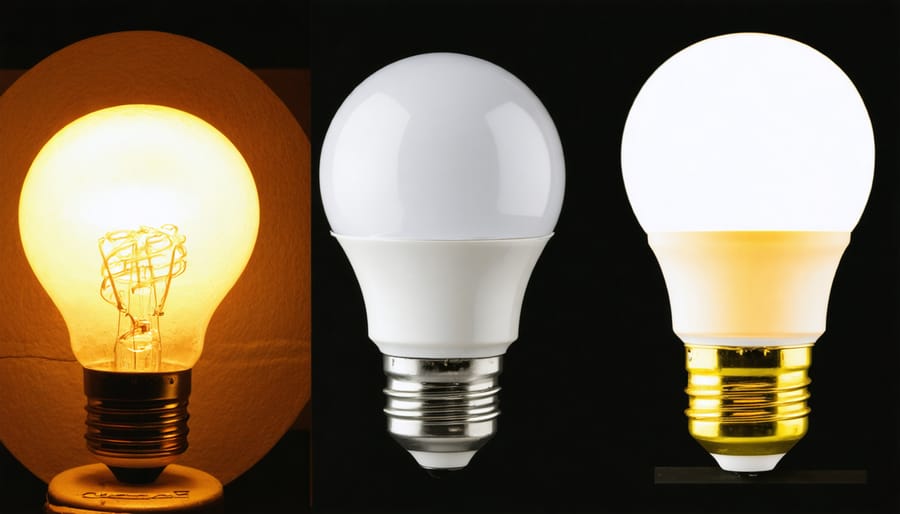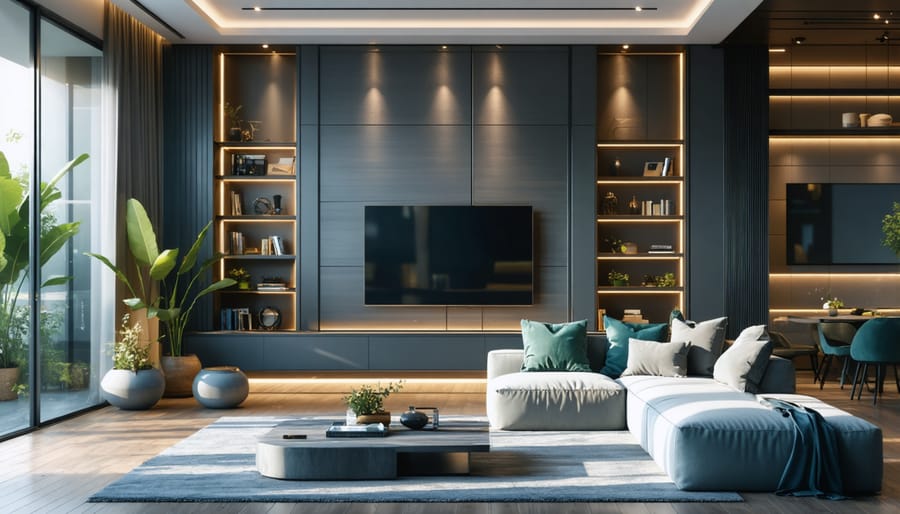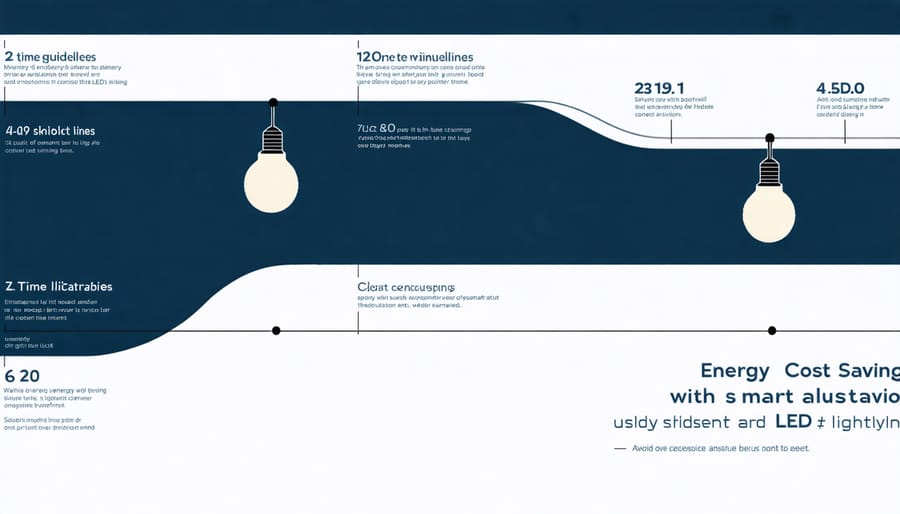Transform your home’s lighting into a beacon of sustainability by implementing smart energy-saving lighting solutions that reduce both environmental impact and utility bills. Modern LED technology now offers warm, adjustable illumination that rivals traditional bulbs while consuming up to 75% less electricity. Strategic placement of motion sensors in high-traffic areas, combined with natural light optimization through well-positioned mirrors and light-colored walls, creates an efficient lighting ecosystem that adapts to your daily routines. Whether you’re retrofitting an existing space or designing a new lighting scheme, today’s innovative solutions offer the perfect blend of functionality, aesthetics, and environmental responsibility – all while maintaining the comfort and ambiance you desire in every room of your home.
The Evolution of Sustainable Lighting Technology
From Incandescent to Smart LEDs
The journey from Edison’s first incandescent bulb to today’s smart LED technology is a testament to human innovation in lighting. In the early 1900s, incandescent bulbs were revolutionary but incredibly inefficient, with 90% of their energy lost as heat. The 1980s saw the rise of compact fluorescent lamps (CFLs), which used about 75% less energy and lasted up to 10 times longer than traditional bulbs.
Enter LED technology in the early 2000s, transforming the lighting industry with its remarkable efficiency and longevity. Modern LEDs use up to 90% less energy than incandescent bulbs and can last for 25,000 hours or more. But the real game-changer came with smart LED technology, introducing features like color changing, dimming, and smartphone control.
Today’s smart LEDs can integrate with home automation systems, respond to voice commands, and even adjust their brightness based on natural light levels. They’re not just about illumination anymore – they’re about creating the perfect ambiance while maximizing energy efficiency. This evolution has turned lighting from a simple utility into an interactive element of our daily lives, helping both our planet and our wallets.

Understanding Modern LED Technology
Today’s LED technology has come a long way from the early days of harsh, bluish light. Modern LEDs use semiconductor chips that convert electrical energy directly into light, making them incredibly efficient compared to traditional bulbs. When electricity passes through these chips, they emit photons – tiny particles of light – in a process that wastes very little energy as heat.
What makes current LED technology truly remarkable is its versatility. You can now choose from a wide range of color temperatures, from warm, cozy yellows to crisp, daylight whites. Most LED bulbs also offer dimming capabilities and can last up to 25,000 hours – that’s about 22 years of normal household use!
The benefits extend beyond just longevity. LEDs use up to 90% less energy than traditional incandescent bulbs, which translates to significant savings on your energy bills. They’re also more durable, contain no mercury, and start up instantly without any warm-up time. Plus, modern LED bulbs come in virtually any shape or size you can imagine, making them perfect for everything from accent lighting to full room illumination.
Smart Lighting Solutions for Every Room
Living Room Lighting Strategies
Creating a well-lit living room starts with understanding the concept of layered lighting, which is essential for any energy-efficient home design. Begin with ambient lighting as your foundation – consider recessed LED downlights or a modern ceiling fixture to provide overall illumination. Space these evenly to eliminate shadows and dark corners.
Next, add task lighting for specific activities. Position floor lamps near reading nooks or desk areas, and table lamps on side tables for cozy evening activities. Wall sconces can frame architectural features while providing additional focused light where needed.
For the final layer, incorporate accent lighting to highlight artwork, plants, or architectural details. LED strip lights behind entertainment centers create a subtle glow, while adjustable track lighting can spotlight favorite décor pieces.
Smart controls make a huge difference in functionality. Install dimmer switches to adjust light levels throughout the day, or opt for smart bulbs that can be controlled via your phone. This allows you to create different moods and save energy by using only the light you need.
Remember to consider natural light when planning your layout. Position mirrors strategically to reflect daylight, and choose light fixtures that complement your window placement. This thoughtful approach to lighting not only enhances your living space but also reduces energy consumption while creating the perfect ambiance for any occasion.

Kitchen and Workspace Illumination
When it comes to kitchen and workspace lighting, the right combination of fixtures can make all the difference in both functionality and comfort. Start with overhead lighting that provides broad, even illumination – LED panels or recessed lights are excellent choices that minimize shadows and reduce energy consumption.
Under-cabinet lighting is a game-changer for food preparation areas. Install LED strips beneath your upper cabinets to eliminate counter shadows and make cooking tasks safer and more enjoyable. These lights also serve as perfect ambient lighting when you want a softer evening atmosphere.
For workspaces like home offices or craft areas, consider adjustable task lighting that you can direct where needed. A combination of natural daylight-mimicking desk lamps and overhead lighting helps reduce eye strain during detail-oriented tasks. Look for fixtures with color temperature controls, allowing you to switch between energizing cool light for productivity and warmer tones for comfort.
Don’t forget about dimmers! Installing dimmer switches gives you complete control over light intensity throughout the day. For instance, bright light for morning meal prep can transition to softer illumination for evening dining.
Pro tip: Position your main light sources to prevent your body from casting shadows on your work area. In the kitchen, this means placing overhead lights slightly in front of where you typically stand rather than directly above.
Remember to layer your lighting – combine ambient, task, and accent lighting to create a versatile space that adapts to different activities and times of day.
Bedroom and Bathroom Lighting
Your bedroom and bathroom deserve lighting that enhances both functionality and relaxation. In the bedroom, create layers of light with a combination of ambient and task lighting. Start with a dimmable ceiling fixture for overall illumination, then add bedside lamps with warm-toned bulbs (2700-3000K) for reading and evening activities.
Consider installing wall sconces on either side of the bed to free up nightstand space while providing directed light for reading. For a modern touch, LED strip lights behind the headboard can create a subtle ambient glow perfect for winding down in the evening.
In the bathroom, even lighting is crucial for grooming tasks. Install vertical fixtures or LED strips on both sides of the mirror to eliminate unflattering shadows. Opt for bright, cool-toned lighting (4000-5000K) around the mirror area for accurate color rendering during makeup application and grooming.
For middle-of-the-night bathroom visits, install a motion-sensor night light or LED strip under the vanity cabinet. This provides enough illumination without being harsh on sleepy eyes. In larger bathrooms, recessed ceiling lights on a dimmer switch offer flexibility for different times of day.
Remember to use water-resistant fixtures in the bathroom, particularly in shower areas or near water sources. Smart bulbs can be programmed to adjust color temperature throughout the day, supporting your natural circadian rhythm and helping maintain healthy sleep patterns.
Smart Controls and Automation
Motion Sensors and Timers
Want to make your home smarter and more energy-efficient? Motion sensors and timers are game-changers in modern lighting solutions. These automated systems ensure lights are only on when needed, potentially cutting your energy bills by 20-30%.
Motion sensors are perfect for areas like garages, walkways, and bathrooms where you often enter with full hands or just need quick access to light. They detect movement within their range and automatically illuminate the space, turning off after a preset period of inactivity. For enhanced security, consider installing motion-activated flood lights around your property’s exterior.
Timers offer another layer of convenience and efficiency. You can program them to match your daily routine – lights turning on as you wake up and off when you leave for work. Smart timers even adjust to seasonal changes in daylight hours, ensuring your outdoor lights activate at sunset year-round.
Pro tip: When installing motion sensors, position them where they won’t be triggered by passing cars or swaying trees. For timers, consider using smart versions that connect to your phone, allowing you to adjust settings remotely and create vacation modes for added security.
Remember to choose the right sensitivity settings for your motion sensors and appropriate time delays – too short might leave you in the dark, too long defeats the energy-saving purpose. With proper setup, these automated solutions provide both convenience and significant energy savings.
Smart Home Integration
Transform your lighting experience by integrating smart technology into your home’s illumination system. Modern smart home automation features allow you to control your lights from anywhere using your smartphone, set automated schedules, and even sync your lighting with other smart devices.
Getting started is easier than you might think. Begin with smart bulbs or switches that connect to your home’s WiFi network. These devices can be controlled through user-friendly apps, voice commands via virtual assistants like Alexa or Google Home, or motion sensors for hands-free operation.
Create customized lighting scenes for different activities – bright and energizing for morning routines, warm and cozy for evening relaxation, or dynamic color changes for entertaining. Many smart lighting systems also offer occupancy simulation when you’re away, enhancing home security.
The real magic happens when you integrate your lighting with other smart devices. Imagine your lights automatically dimming when you start a movie, brightening gradually in the morning as your alarm goes off, or flashing when your doorbell rings. These automations not only add convenience but can significantly reduce energy waste by ensuring lights are only on when needed.
Most systems are expandable, allowing you to start small and add more features as your needs grow. Consider beginning with high-traffic areas like your living room or entryway, then expanding to other spaces over time.
Cost-Benefit Analysis
Initial Investment vs Long-term Savings
While LED and smart lighting solutions may seem expensive at first glance, they’re actually one of the smartest investments you can make for your home. Let’s break down the numbers: A typical LED bulb costs about $3-8, compared to $1-2 for traditional incandescent bulbs. However, LEDs last up to 25 times longer and use about 75% less energy than their old-school counterparts.
Here’s what this means for your wallet: If you replace just 10 traditional bulbs with LEDs, you could save around $50-100 annually on your energy bills. Over the typical 10-year lifespan of LED bulbs, that’s $500-1,000 in savings! Smart lighting systems, while requiring a bigger upfront investment of $100-300, can reduce your energy consumption even further through automated scheduling and motion sensing.
Think of it this way: the initial cost is like paying for several years of electricity upfront, but at a massive discount. Plus, you’ll spend less time and money replacing burnt-out bulbs, making sustainable lighting a bright idea for both your home and your budget.

Environmental Impact
Making environmentally conscious lighting choices isn’t just good for the planet – it’s great for your wallet too. Modern lighting solutions have evolved to become more efficient and eco-friendly than ever before, making them an essential part of sustainable home solutions. By switching to LED bulbs, you can reduce your lighting-related energy consumption by up to 75% compared to traditional incandescent bulbs, significantly decreasing your carbon footprint.
Smart lighting systems take this efficiency even further by automatically adjusting brightness levels and turning off lights in unused rooms. This intelligent approach to lighting management can cut energy waste by an additional 20-30%. Additionally, LED bulbs last up to 25 times longer than traditional bulbs, which means fewer replacements and less waste in landfills.
Natural light optimization through strategic window placement and light-reflecting surfaces can reduce your reliance on artificial lighting during daylight hours. Combined with motion sensors and dimming capabilities, these solutions create a perfect balance between comfort and conservation, helping you maintain a more sustainable lifestyle while creating the perfect ambiance in your home.
As we’ve explored throughout this guide, bright lighting solutions aren’t just about illuminating our spaces – they’re about creating a more sustainable and energy-efficient future for our homes and our planet. By embracing LED technology, smart lighting systems, and natural light optimization, you’re not only reducing your energy bills but also making a positive impact on the environment.
Remember that every small change counts. Starting with simple switches like replacing traditional bulbs with LEDs or installing motion sensors in less-frequented areas can lead to significant energy savings over time. Smart lighting systems, while requiring a bigger initial investment, offer unprecedented control and efficiency that pays off in the long run.
The future of home lighting is bright, sustainable, and within your reach. Whether you’re renovating your entire home or making gradual improvements, there’s a solution that fits your needs and budget. Consider implementing some of the strategies we’ve discussed – from daylight harvesting to zone lighting – and watch as your space transforms into an energy-efficient haven.
Take the first step today toward a more sustainable lighting setup. Your wallet will thank you, your home will shine brighter, and you’ll be contributing to a greener future for generations to come. After all, the best time to make a positive change is now, and every bright idea counts toward a more sustainable tomorrow.
